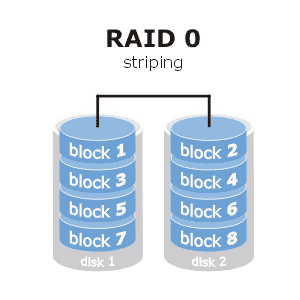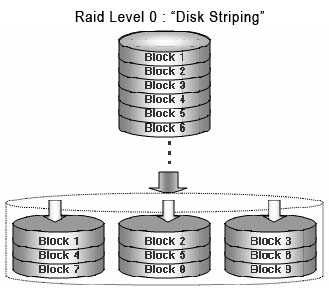RAID Level 0
Definition:
RAID 0, or Redundant Array of Independent Disks, Level 0 – also called striping – is a method of storing data on multiple computer storage devices – usually hard disks or disk partitions – by interleaving the data and spreading it across the devices usually achieving faster read and write speeds.
Common Name(s):
RAID 0. (Note that the term “RAID 0” is sometimes used to mean not only the conventional striping technique described here but also other “non-redundant” ways of setting up disk arrays. Sometimes it is (probably incorrectly) used just to describe a collection of disks that doesn’t use redundancy.)
Description:
The simplest RAID level, RAID 0 should really be called “RAID”, since it involves no redundancy. Files are broken into stripes of a size dictated by the user-defined stripe size of the array, and stripes are sent to each disk in the array. Giving up redundancy allows this RAID level the best overall performance characteristics of the single RAID levels, especially for its cost. For this reason, it is becoming increasingly popular by performance-seekers, especially in the lower end of the marketplace.


Controller Requirements: Supported by all hardware controllers, both SCSI and IDE/ATA, and also most software RAID solutions.
Hard Disk Requirements: Minimum of two hard disks (some may support one drive, the point of which escapes me); maximum set by controller. Any type may be used, but they should be of identical type and size for best performance and to eliminate “waste”.
Array Capacity: (Size of Smallest Drive * Number of Drives).
Storage Efficiency: 100% if identical drives are used.
Fault Tolerance: None. Failure of any drive results in loss of all data, short of specialized data recovery.
Availability: Lowest of any RAID level. Lack of fault tolerance means no rapid recovery from failures. Failure of any drive results in array being lost and immediate downtime until array can be rebuilt and data restored from backup.
Degradation and Rebuilding: Not applicable.
Random Read Performance: Very good; better if using larger stripe sizes if the controller supports independent reads to different disks in the array.
Random Write Performance: Very good; again, best if using a larger stripe size and a controller supporting independent writes.
Sequential Read Performance: Very good to excellent.
Sequential Write Performance: Very good.
Cost: Lowest of all RAID levels.
Special Considerations: Using a RAID 0 array without backing up any changes made to its data at least daily is a loud statement that that data is not important to you.
Recommended Uses: Non-critical data (or data that changes infrequently and is backed up regularly) requiring high speed, particularly write speed, and low cost of implementation. Audio and video streaming and editing; web servers; graphic design; high-end gaming or hobbyist systems; temporary or “scratch” disks on larger machines.
Tools for RAID 0
Clone RAID array to another RAID or physical disk without reinstalling Windows
Resize RAID virtual partition to solve low disk space problem and improve computer performance.
Recover deleted, formatted and lost data with RAID data recovery software
